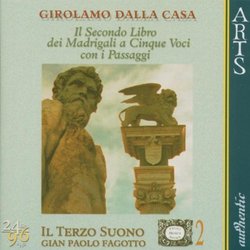| All Artists: Anonymous, Girolamo della Casa, Giovanni Battista Della Gostena, Il Terzo Suono, Adriano Dallape, Elena Cecchi Fedi, Laura Fabris, Gian Paolo Fagotto Title: Girolamo Dalla Casa: Il Secondo Libro dei Madrigali a Cinque Voci con i Passaggi Members Wishing: 0 Total Copies: 0 Label: Arts Music Original Release Date: 1/1/2003 Re-Release Date: 7/29/2003 Genre: Classical Styles: Opera & Classical Vocal, Chamber Music, Historical Periods, Classical (c.1770-1830) Number of Discs: 1 SwapaCD Credits: 1 UPC: 600554756127 |
Search - Anonymous, Girolamo della Casa, Giovanni Battista Della Gostena :: Girolamo Dalla Casa: Il Secondo Libro dei Madrigali a Cinque Voci con i Passaggi
 | Anonymous, Girolamo della Casa, Giovanni Battista Della Gostena Girolamo Dalla Casa: Il Secondo Libro dei Madrigali a Cinque Voci con i Passaggi Genre: Classical |
Larger Image |
CD Details |
CD ReviewsGiordano's Pick of the Month Giordano Bruno | Wherever I am, I am. | 04/28/2009 (5 out of 5 stars) "Among cornettists, violinists, gambists, and other players of late Renaissance instruments, Girolamo dalla Casa (1530-1601) is a familiar name, more famous, dare I say, than John Lennon of the Beatles. His 'textbook' on playing diminutions -- virtuosic flourishes of fast notes dividing the pitches of a melodic line into intricate, semi-improvisatory passagi -- titled "I Vero Modo di Diminuir con Tutte le sorti di Stromenti (1584), is the exercise book for every serious performer of Monteverdi, Gabrieli, etc. I myself turn to it for practice sessions at least once a week. Dalla Casa himself was apparently a formidable cornettist, employed by the civic authorities of Venice to perform frequent concerts from the galleries of San Marco. Modern cornettists Bruce Dickey and Doron Sherwin have both recorded showy CDs featuring 'passagi' From "Il Vero Modo." The notes that come with this CD, written by Paolo Fagotto, discuss the historic importance of 'division' playing in the evolution of Baroque and later styles with considerable insight and clarity.
Jean Tubery plays the cornetto on this CD, and I've never heard more elegant and polished playing, but the big surprise here is the quality of dalla Casa's five-part madrigals. "Il Vero Modo" uses madrigals by other composers as 'launching pads' for the diminutions, which are almost obsessively flamboyant. In his "Secondo Libro de Madrigali", dalla Casa balances his flights of virtuosity with solid and restrained passages of polyphony, with subtle attention to the expressive qualities of the texts being sung. Dalla Casa's madrigals are less adventuresome in terms of harmony and dissonance than those of the Ferrarese and Mantuan composers like Marenzio and Gesualdo, but they are if anything more progressive in structure, more premonitory of the shapes that music would take in the 17th C. They are also decidedly less morose and tormented; lovers must have had more pleasure for their efforts in the Veneto! In every way, these are very fine madrigals and dalla Casa ranks among the best in the genre. Besides Tubery, the instrumentalists on this CD include Vittorio Ghielmi on the rare viola bastarda, Francesco Tapella on lute, and Adriano Dallapè on organetto/harpsichord. they all get their chance to dazzle with passagi. The singers of Il Terzo Suono -- Elena Cecchi Fedi and Laura Fabris, sporanos; Roberto Balconi, alto; Gain Paolo Fagotto, tenor; and Antonio Abete, bass -- have two tasks here, the ensemble polyphony of the madrigals and the acrobatic soloist singing of the passagi. They are splendid at both, the sopranos especially proving that their voices can do anything the hottest cornetto can do. The 24 bit-96 kHz recording technology deserves some plaudits also; play this CD in the next room and you'll swear your house has become a studio. This is Giordano's "must buy" CD for April, 2009. You'll thank me for it." |
